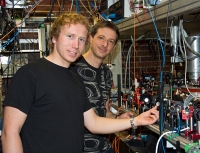
[2013-03-19] A team of physicists led by Lukas Slodička and Markus Hennrich achieved an international first by entangling two distant atoms through the detection of a single light particle. This type of entanglement of quantum objects is considerably more efficient than previous methods and may be used for large-scale quantum networks in the future.
Scientists at the Institute for Experimental Physics of the University of Innsbruck have implemented a proposal made in 1999 by theoretical physicists Carlos Cabrillo and Peter Zoller. In this current experiment the researchers entangled two distant atoms via the emission and measurement of a single photon (light particle). The two charged barium atoms, held in an ion trap, were laser cooled and excited. PhD student Lukas Slodička explains how they simulated the spatial distance between the two atoms, which are located directly next to each other in the ion trap: “The photons emitted from the first atom were collected in an optical fiber. We then sent the photons coming from the second atom to a distant mirror, which reflected them into the same optical fiber. In this way we established an effective distance of one meter between the quantum particles.” This scheme also guarantees an important part of this experiment: “If the detector at the end of the optical fiber cannot identify which atom the photon came from, the quantum states of the two atoms are entangled,” says Slodička.
High accuracy and efficiency
The experimental physicists, who are part of Rainer Blatt’s research group, have to work with nanometer accuracy to guarantee stable measurements. “When these conditions are satisfied, we achieve a high entanglement generation rate with this experimental approach,” says Markus Hennrich. In previous experiments, each atom needed to send one photon to the detectors. “In order to detect two photons, about one million measurements had to be taken,” says the Slovakian Lukas Slodička, who has been researching in Innsbruck since 2008. “With our new scheme, the entanglement-generation rate increases by at least two orders of magnitude for typical experimental parameters, because it is sufficient to detect only a single light particle.” This is tremendous progress and of great importance for practical application.
Manifold application
“We are now able to generate entanglement of the internal states of two atoms via emission and detection of a single photon with high accuracy and high efficiency,” says Markus Hennrich. “At the same time, our system enables us to perform quantum operations with the single atoms.” This opens new application possibilities in large-scale quantum networks. “For example, with this method we could connect two quantum computers via optical fibers,” suggests Slodička. Many proposals for future quantum technologies, e.g. for communication, cryptography or data processing, rest upon such efficient generation of quantum entanglement between distant particles.
The results of the study are published in the journal Physical Review Letters. The work is supported by the Austrian Science Fund (FWF), the European Union and Tyrolean Industries.